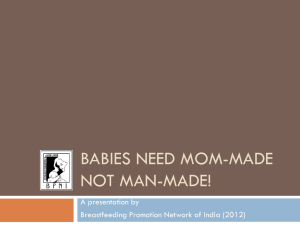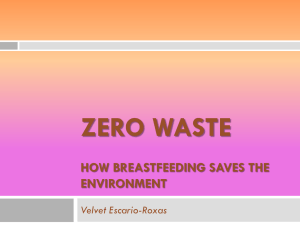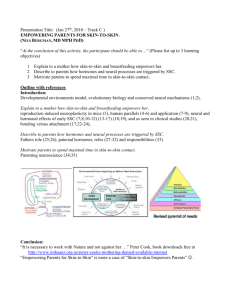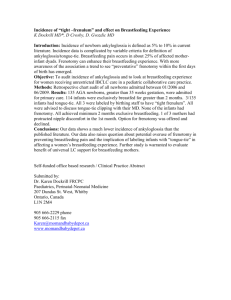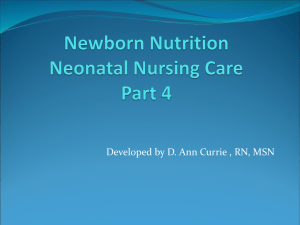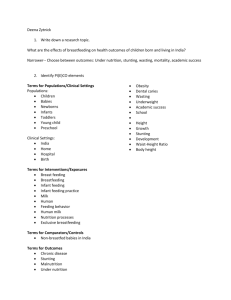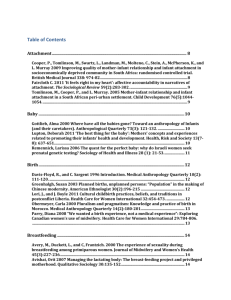References/Abstract Handout
advertisement
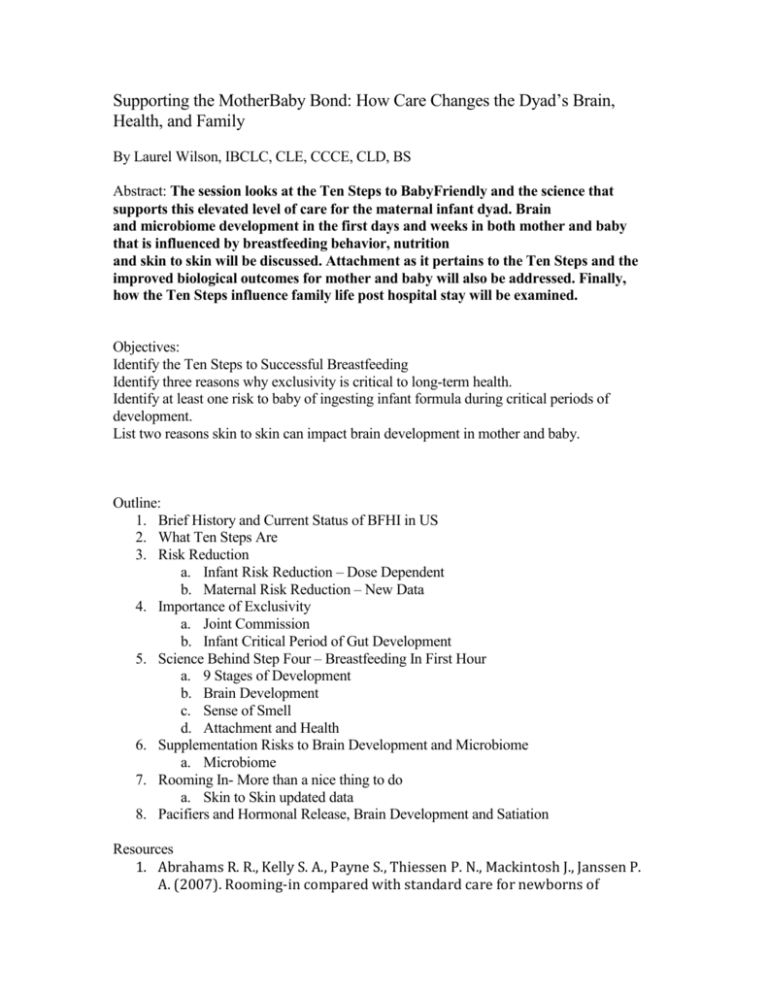
Supporting the MotherBaby Bond: How Care Changes the Dyad’s Brain, Health, and Family By Laurel Wilson, IBCLC, CLE, CCCE, CLD, BS Abstract: The session looks at the Ten Steps to BabyFriendly and the science that supports this elevated level of care for the maternal infant dyad. Brain and microbiome development in the first days and weeks in both mother and baby that is influenced by breastfeeding behavior, nutrition and skin to skin will be discussed. Attachment as it pertains to the Ten Steps and the improved biological outcomes for mother and baby will also be addressed. Finally, how the Ten Steps influence family life post hospital stay will be examined. Objectives: Identify the Ten Steps to Successful Breastfeeding Identify three reasons why exclusivity is critical to long-term health. Identify at least one risk to baby of ingesting infant formula during critical periods of development. List two reasons skin to skin can impact brain development in mother and baby. Outline: 1. Brief History and Current Status of BFHI in US 2. What Ten Steps Are 3. Risk Reduction a. Infant Risk Reduction – Dose Dependent b. Maternal Risk Reduction – New Data 4. Importance of Exclusivity a. Joint Commission b. Infant Critical Period of Gut Development 5. Science Behind Step Four – Breastfeeding In First Hour a. 9 Stages of Development b. Brain Development c. Sense of Smell d. Attachment and Health 6. Supplementation Risks to Brain Development and Microbiome a. Microbiome 7. Rooming In- More than a nice thing to do a. Skin to Skin updated data 8. Pacifiers and Hormonal Release, Brain Development and Satiation Resources 1. Abrahams R. R., Kelly S. A., Payne S., Thiessen P. N., Mackintosh J., Janssen P. A. (2007). Rooming-in compared with standard care for newborns of 2. 3. 4. 5. 6. 7. mothers using methadone or heroin. Canadian Family Physician, 53(10), 1722-1730. BabyFriendly USA. BabyFriendlyUSA Website. www.babyfriendlyusa.org. Bartels A, Zeki S. The neural correlates of maternal and romantic love. Neuroimage 2004;21:1155–1165. Becker G, Remmington S and Remmington T (2011) Early additional food and fluids for healthy breastfed full-term infants (Review) The Cochrane Library. Issue 12. Bergman NJ, Linley LL, Fawcus SR (2004) Randomised controlled trial of skin-to-skin contact from birth versus conventional incubator for physiological stabilization in 1200 to 2199 gram newborns, Acta Paediatr, Jun 93(6) pp 779-85. Bergman K, Sarkar P, Glover V, O’Connor T (2010) Maternal Prenatal Cortisol and Infant Cognitive Development: Moderation by Infant–Mother Attachment, Biological Psychiatry 67 (11), pp 1026-1032. Bogoch, Y et al. Anxiety induced by prenatal stress is associated with suppression of hippocampal genes involved in synaptic function. J Neurochem. 2007 May;101(4):1018-30. Epub 2007 Jan 24. 8. Brimdyr, K. The Magical Hour: Holding Your Baby Skin to Skin During the First Hour after Birth. DVD 9. Brimdyr K, Widströ m AM, Cadwell K, Svensson K, Turner- Maffei C (2012) A Realistic Evaluation of Two Training Programs on Implementing Skin-to-Skin as a Standard of Care, Journal of Perinatal Education, Volume 21, Number 3, pp 149-157(9). 10. Bystrova, K., Matthiesen, A. S., Widstrom, A. M., Ransjo-Arvidson, A. B., Welles-Nystrom, B., Vorontsov, I., et al. (2007). The effect of Russian Maternity Home routines on breastfeeding and neonatal weight loss with special reference to swaddling. Early Human Development, 83(1), 29-39. 11. Champagne FA., Weaver IC., Dioro J., Dymov S., Szyf M., Meaney MJ. Maternal care associated with methylation of the estrogen receptoralpha1b promoter and estrogen receptor-alpha expression in the medial preoptic area of female offspring. Endocrinology. 2006;147:2909–2915. 12. Childre, Doc and Martin, Howard. The Heartmath Solution. Harper Collins, 1999. 13. Colorado Department of Public Health. Getting it Right After Delivery. August 2007. https://www.colorado.gov/pacific/sites/default/files/PF_MCH_Getting-itRight-After-Delivery.pdf 14. Costandi, Moheb. Microbes on Your Mind, Scientific American Mind 23, 32 (2012). 15. Dumas, L et al. Influence of skin-to-skin contact and rooming-in on early mother-infant interaction: a randomized controlled trial. Clin Nurs Res. 2013 Aug;22(3):310-36. doi: 10.1177/1054773812468316. Epub 2013 Jan 3. 16. Elizur, A et al. Mislabelled cow's milk allergy in infants: a prospective cohort study. Arch Dis Child, 2012. doi:10.1136/archdischild-2012-302721 17. Entwistle FM (2013) The evidence and rationale for the UNICEF UK Baby Friendly Initiative standards. UNICEF UK. 18. Feng, Jiexiong et al. Heparin-binding epidermal growth factor–like growth factor decreases the incidence of necrotizing enterocolitis in neonatal rats. Journal of Pediatric Surgery , Volume 41 , Issue 1 , 144 – 149, 2006. 19. Figueredo SF, Mattar MJG, Abrã o ACFV (2012) Baby-friendly Hospital Initiative – a policy of promoting, protecting and supporting breastfeeding, Acta Paul Enferm. 25(3) pp 459-63. 20. Flaherman VJ, Gay B, Scott C, Avins A, Lee KA, Newman TB (2012) Randomised trial comparing hand expression with breast pumping for mothers of term newborns feeding poorly, Arch DIs Child Fetal Neonatal Ed. Jan; 97(1): F 18-23. doi:10.1136/adc.2010.209213. 21. Fleming AS, Corter C, Stallings J, Steiner M. Testosterone and prolactin are associated with emotional responses to infant cries in new fathers. Horm Behav. 2002;42:399–413. [PubMed] 22. Garrido D, Dallas DC, Mills DA (2013) Consumption of human milk glycoconjugates by infant-associated bifidobacteria: mechanisms and implications. Microbiology,159, 649–664. DOI 10.1099/mic.0.0641130064113 23. Harlow, Harry. (1958) The Nature of Love. American Psychologist, 13, 673685. 24. Hassiotou, Foteini et al. (2015) Breastmilk Imparts the Mother's Stem Cells to the Infant. FASEB J April 29:876.8 25. Horta BL, Victoria CG (2013) Long-term effects of breastfeeding: a systematic review, WHO, Geneva. 26. Hurst A. (2013). Rooming-in for newborns: Implementing. In D. Pravikoff (Ed.), CINAHL nursing guide (pp. 1-5). Ipswich, MA: EBSCO Publishing. 27. Iacovou M, Sevilla-Sanz A (2010) The effect of breastfeeding on children’s cognitive development, Institute for Social and Economic Research, University of Essex, 2010-40 28. Lundstrom et al. Maternal status regulates cortical responses to the body odor of newborns. Front Psychol. 2013; 4: 597. 29. McNeil et al. What are the risks associated with formula feeding? A reanalysis and review. Birth. 2010 Mar;37(1):50-8. doi: 10.1111/j.1523536X.2009.00378.x. 30. Medoff Cooper, B., Holditch-Davis, D., Verklan, M. T., Fraser-Askin, D., Lamp, J., Santa-Donato, A., Onokpise, B. Soeken, K. L., & Bingham, D. (2012). Newborn clinical outcomes of the AWHONN late preterm infant researchbased practice project. J Obstet Gynecol Neonatal Nurs, 41(6), 774-785. doi: 10.1111/j.1552-6909.2012.01401.x 31. Moore ER, Anderson GC, Bergman N, Dowswell T (2012) Early skin-to-skin contact for mother and their healthy newborn infants (Review) The Cochrane Library, Issue 5. 32. Morgan, BE et al. Should neonates sleep alone? Biol Psychiatry. 2011, 70(9); 817-829. 33. Mullen K., Conrad L., Hoadley G., Iannone D. (2007). Family-centered maternity care: One hospital's quest for excellence. Nursing for Women's Health, 11(3), 282-290. doi:10.1111/j.1751-486X.2007.00166.x 34. Murray, E, Dellaport, J, Ricketts, S, Getting It Right After Delivery: Five Hospital Practices That Support Breastfeeding, Colorado Department of Public Health and Environment, August 2007. 35. Parker, L. A., Sullivan, S., Krueger, C., Kelechi, T., & Mueller, M. (2012). Effect of early breast milk expression on milk volume and timing of lactogenesis stage II among mothers of very low birth weight infants: A pilot study. Journal of Perinatology, 32, 205–209. 36. Penn et al. Digested formula but not digested fresh human milk causes death of intestinal cells in vitro: implications for necrotizing enterocolitis. Pediatric Research (2012) 72, 560–567 doi:10.1038/pr.2012.125 37. Phillips, C. (2003). Family-Centered Maternity Care. Sudbury, MA: Jones and Bartlett. 38. Preer, G., Pisegna, J. M., Cook, J. T., Henri, A. M., & Philipp, B. L. (2013). Delaying the Bath and In-Hospital Breastfeeding Rates. Breastfeed Med. doi: 10.1089/bfm.2012.0158 39. Shafai, Touraj, et al. The Association of Early Weaning and Formula Feeding with Autism Spectrum Disorders. Breastfeeding Medicine. Vol 9, No. 5, 2014. 40. Spatz, Diane and Lessen, Rachelle. The Risks of Not Breastfeeding. ILCA. 2011. 41. Staarup et al. The stereospecific triacylglycerol structures and fatty acid profiles of human milk and infant formulas. Journal of Pediatric Gastroenterology and Nutrition, 42, 293-299. 42. Stolzeberg, DS. Histone deacetylase inhibition induces long-lasting changes in maternal behavior and gene expression in female mice. Endocrinology. 2014 Sep;155(9):3674-83. doi: 10.1210/en.2013-1946. Epub 2014 Jun 16. 43. Waller-Wise R. (2012). Mother-baby care: The best for patients, nurses and hospitals. Nursing for Women's Health, 16(4), 273-278. doi:10.1111/j.1751486X.2012.01744.x 44. Weisstaub, G et al. Non-breast milk feeding in developing countries: challenge from microbial and chemical contaminants. Ann Nutr Metab. 2012;60(3):215-9. doi: 10.1159/000338203. Epub 2012 Jun 6. 45. WHO (2013) Country implementation of the International Code of Marketing of Breast-milk Substitutes: Status report 2011.ISBN 978 92 4 150598 7

